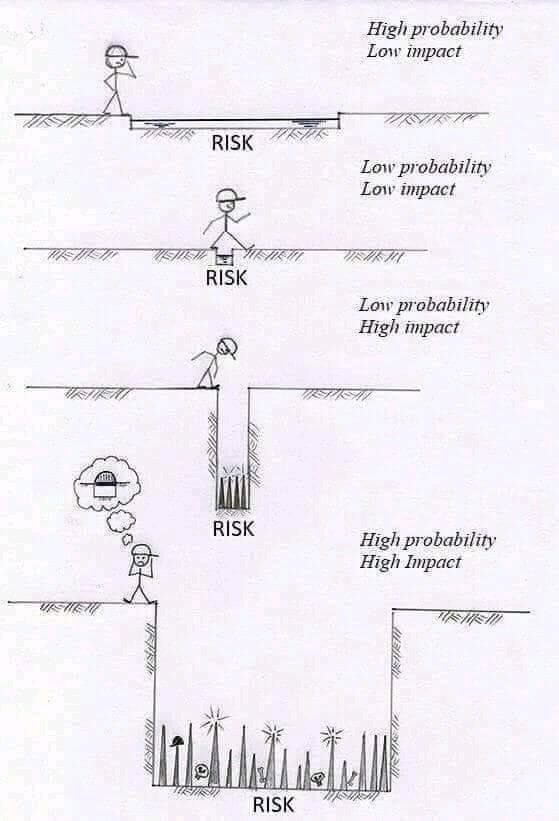Justin Case and Risk Management?
04/07/2019

Have any of you come across this ubiquitous fellow “Justin Case”? He seems to raise his ugly head every time someone suggests trying something new. “Oh, we can’t change that process, Just-in Case the regulator gives us a poor grading!”, I’ve heard people say. Or, “We have to have separate quality checks, Just-in Case there’s a health & safety problem!”. Or, “We can’t ask staff to stop doing that as we had a real problem once where somebody almost got injured so the Unions won’t allow us to stop”.
The real issue is 2 fold;
- People engage their biases (see Daniel Kahneman, Thinking Fast & Slow) as soon as they’re challenged. Kahneman (in his book) talks primarily about System 1 and System 2. System 1 involves the emotional side of our personality as opposed to System 2 – our logical or rational side. The emotional side is not bad, most of the time it’s actually doing its job (to keep the host alive!). By design the brain rapidly develops potentially harmful situations to avoid!
- Very few people are educated (if at all) on how to properly assess or, dare I say it, calculate RISK!
These two factors are a real road-block to improving or transforming an organisation, creating reasons for not doing anything.
The picture above sums up pretty well how to properly visualise risk in a simple format most people could understand in their heads! Referring back to Kahneman, this is engaging system 2!
We have even witnessed a company turning down a contract through not hosting desensitised police data on a server, Just-in Case, staff could be held at gunpoint in their car park and threatened by criminals wanting access to this data! In 2018 IBM reported the average cost per loss of stolen data to be $3.8M of which 48% was through a malicious or criminal attack ($1.57M) and 9% was in the UK ($141,300). None of these thefts was reported within the Criminal Justice arena. Also the majority of these thefts would presumably have happened through online hacking (further reducing the probability that you are not safe in the carpark!). Further, on checking all sources I knew or read about who were involved in police data (including highly sensitive data), no-one had come across any criminals threatening staff in order to gain access to data! So the chances are as close to 0 as you can get. But, being safety biased (something else from Kahneman), let’s borrow a well-known probability which is well-known in the airline industry. The probability of dying in an airplane crash is 0.00002%. Using this number we can actually calculate the maximum risk to the organisation;
Risk = Probability x Loss
< 0.00002% x $141,300
< $0.028
So even if this was calculated on an hourly or daily basis this contract would probably have been worth it! But I bet that company flies people around the world without giving it a thought!
Seems to me, the picture above says it quite clearly – you have to look at the probability as well as the impact (or loss) – and rather than engaging the high-cost Just-in Case, just engage proper risk management!
Categories & Tags:
Leave a comment on this post:
You might also like…
Keren Tuv: My Cranfield experience studying Renewable Energy
Hello, my name is Keren, I am from London, UK, and I am studying Renewable Energy MSc. My journey to discovering Cranfield University began when I first decided to return to academia to pursue ...
3D Metal Manufacturing in space: A look into the future
David Rico Sierra, Research Fellow in Additive Manufacturing, was recently involved in an exciting project to manufacture parts using 3D printers in space. Here he reflects on his time working with Airbus in Toulouse… ...
A Legacy of Courage: From India to Britain, Three Generations Find Their Home
My story begins with my grandfather, who plucked up the courage to travel aboard at the age of 22 and start a new life in the UK. I don’t think he would have thought that ...
Cranfield to JLR: mastering mechatronics for a dream career
My name is Jerin Tom, and in 2023 I graduated from Cranfield with an MSc in Automotive Mechatronics. Originally from India, I've always been fascinated by the world of automobiles. Why Cranfield and the ...
Bringing the vision of advanced air mobility closer to reality
Experts at Cranfield University led by Professor Antonios Tsourdos, Head of the Autonomous and Cyber-Physical Systems Centre, are part of the Air Mobility Ecosystem Consortium (AMEC), which aims to demonstrate the commercial and operational ...
Using grey literature in your research: A short guide
As you research and write your thesis, you might come across, or be looking for, ‘grey literature’. This is quite simply material that is either unpublished, or published but not in a commercial form. Types ...






